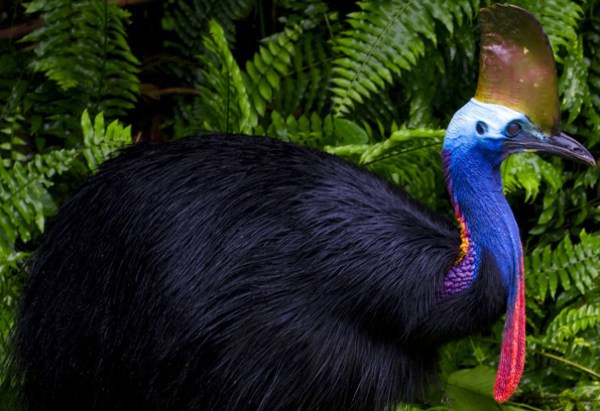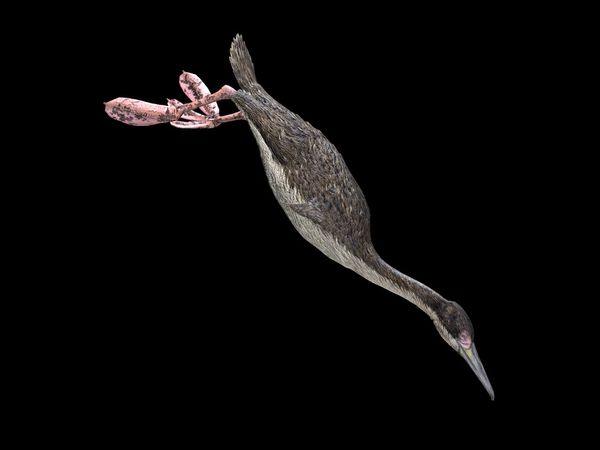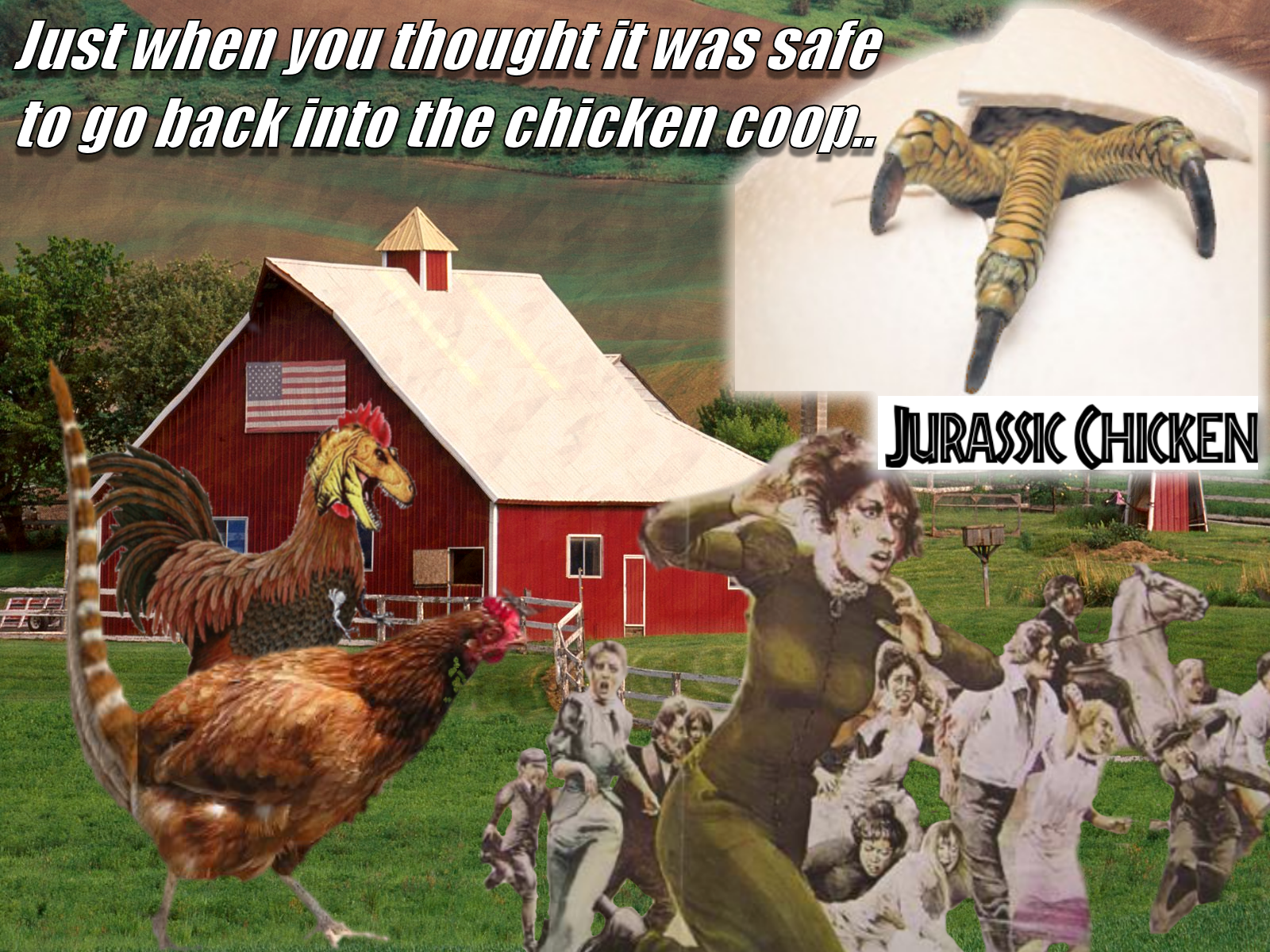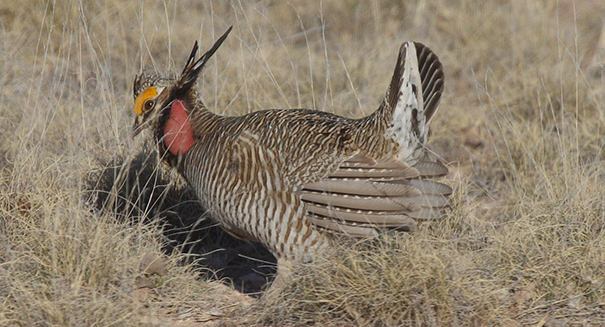It looks like you're using an Ad Blocker.
Please white-list or disable AboveTopSecret.com in your ad-blocking tool.
Thank you.
Some features of ATS will be disabled while you continue to use an ad-blocker.
share:
Just in time, before new Jurassic Park movie...
If you follow science and know who Dr. Jack Horner is, the same Jack Horner that was scientist helping Spielberg create blockbuster movie Jurassic Park, you probably have heard of term Chickenosaurus.
In his Ted Talk Dr. Horner actually points that what we have seen in movie actually can't be reproduced, it's bad science, but great movie blockbuster. But at the same time he points to research currently undergoing to turn velociraptor's closest relative, chickens, back into dinosaurs, because they have all required genes already, but they are just turned off.
Well, here are newst results about research undergoing...
Source: www.statecolumn.com...
This news makes me wonder what our creationist friends think about clear scientific evidence that dinosaurs evolved into birds/chickens and what is their take on research - should we support such research or should we stop it, as it just does not go well with creationism claims.
If you follow science and know who Dr. Jack Horner is, the same Jack Horner that was scientist helping Spielberg create blockbuster movie Jurassic Park, you probably have heard of term Chickenosaurus.
In his Ted Talk Dr. Horner actually points that what we have seen in movie actually can't be reproduced, it's bad science, but great movie blockbuster. But at the same time he points to research currently undergoing to turn velociraptor's closest relative, chickens, back into dinosaurs, because they have all required genes already, but they are just turned off.
Well, here are newst results about research undergoing...
Scientists trying to establish the evolutionary explanation for massive prehistoric reptiles eventually becoming modern-day birds have manipulated the proteins of embryonic chickens to make their beaks take the form of a dinosaur snout, according to a study published in the journal Evolution this Tuesday.
According to lead author Bhart-Anjan Bhullar, a Yale paleontologist, reversing the process by which chickens develop beaks so that they would grow a “snout” wasn’t difficult to do at all. He says the beak was a fairly recent development in bird evolution, coming long after birds developed the ability to fly. Beaks come in all shapes and sizes, and represent the specialization that species come to adapt in order to survive in unique habitats. Before beaks emerged, bird noses were blunt and primitive.
Bones called premaxillae, situated near the front of most animal jaws, eventually came to form what we know as beaks today. Over the course of thousands of years, chickens’ premaxillae fused and elongated, morphing into something that more resembles the beaks we recognize today.
Source: www.statecolumn.com...
This news makes me wonder what our creationist friends think about clear scientific evidence that dinosaurs evolved into birds/chickens and what is their take on research - should we support such research or should we stop it, as it just does not go well with creationism claims.
edit on 13-5-2015 by SuperFrog because: (no reason given)
edit on 5/13/2015 by tothetenthpower because: (no reason
given)
They always make T-rex out to be a ferocious monster in those movies. And in reality he is just a big chicken.
Talk about Hollywood twisting things around.
Talk about Hollywood twisting things around.
I was going to post this yesterday until I did a search. This story is originally from 2011 and I'm not sure if they've achieved anything new. I
admit, I didn't compare the two articles.
Scientists seek to turn chickens into mini-dinosaurs
www.abovetopsecret.com...
EDIT: Here's the link to the journal.
Source
Scientists seek to turn chickens into mini-dinosaurs
www.abovetopsecret.com...
EDIT: Here's the link to the journal.
Source
The avian beak is a key evolutionary innovation whose flexibility has permitted birds to diversify into a range of disparate ecological niches. We approached the problem of the mechanism behind this innovation using an approach bridging paleontology, comparative anatomy, and experimental developmental biology. First we used fossil and extant data to show the beak is distinctive in consisting of fused premaxillae that are geometrically distinct from those of ancestral archosaurs. To elucidate underlying developmental mechanisms, we examined candidate gene expression domains in the embryonic face: the earlier frontonasal ectodermal zone (FEZ) and the later midfacial Wnt-responsive region, in birds and several reptiles. This permitted the identification of an autapomorphic median gene expression region in Aves. In order to test the mechanism, we used inhibitors of both pathways to replicate in chicken the ancestral amniote expression. Altering the FEZ altered later Wnt responsiveness to the ancestral pattern. Skeletal phenotypes from both types of experiments had premaxillae that clustered geometrically with ancestral fossil forms instead of beaked birds. The palatal region was also altered to a more ancestral phenotype. This is consistent with the fossil record and with the tight functional association of avian premaxillae and palate in forming a kinetic beak.
edit on 13-5-2015 by eisegesis because: (no reason given)
a reply to: SuperFrog
Wait wait! Do you think we can call this DEvolution? I usually tell people that organisms can't devolve because evolution always proceeds forward, but this is actually taking an organism and reverting it to a prior evolutionary form (at least one part of the organism).
Wait wait! Do you think we can call this DEvolution? I usually tell people that organisms can't devolve because evolution always proceeds forward, but this is actually taking an organism and reverting it to a prior evolutionary form (at least one part of the organism).
Yes, multiple teams working on this what Krazysh0t rightfully calls DEvolution makes it hard to follow all research done and progress that has been
mode.
Thanks for sharing of the links.
Thanks for sharing of the links.
Back in the day...
We raised a Turkey one year when we lived in the high desert of California. Before Jurassic park from just seeing that thing while it was young walking around the Joshua trees and sand with little/few feathers gave me the very distinct impression it came Dinosaurs.
Then it grew up, got all it's feathers and became nice and plump, we had no choice but to eat it
We raised a Turkey one year when we lived in the high desert of California. Before Jurassic park from just seeing that thing while it was young walking around the Joshua trees and sand with little/few feathers gave me the very distinct impression it came Dinosaurs.
Then it grew up, got all it's feathers and became nice and plump, we had no choice but to eat it
My mom still grows and butchers her own chickens. She purchased some "large breasted" fryers. She didnt realize they were geneticly modified, and
she didnt get them butchered on time, so the breasts got so huge, the hens couldnt walk, and the breasts began blowing up and killing the hens.
They didnt look like dinosaurs though.
They didnt look like dinosaurs though.
The common chicken is a direct descendant of the velociraptor. As it develops in the egg it shows many common traits with them including a membrane in
its beak which closely resembles its ancestors teeth.The scientists involved were or are trying to genetically modify the chicken back to its
velociraptor beginnings. Dont know whether this bodes well for mankind or not
Not sure how many of you have seen or heard about Southern Cassowarry, but those birds to me have all signs of their ancestors, dinosaurs.

Sources:
listverse.com...
en.wikipedia.org...

The Southern Cassowarry is a rainforest dwelling member of the ratite family, native to Northwestern Australia and New Guinea. Cassowaries have black plumage and blue skin patches, with a bony head plate that gives it a saurian appearance. These birds weigh over 130 pounds, stand nearly 6 feet tall, and are fiercely territorial.
Armed with razor sharp spurs and one of the strongest kick forces of any animal, Cassowaries will not hesitate to challenge a perceived threat. Human intruders into Cassowary habitat have been ripped open, disemboweled or killed instantly by the force and slicing effect of a Cassowary attack
Sources:
listverse.com...
en.wikipedia.org...
a reply to: SuperFrog
Nice pic, still has a "modern" beak though. I wonder when the long tongue on the hummingbird came into being via evolution, hard to imagine the ancient dinos running around with huge tongues (or to quote the wolf, 'better to eat you with'). Random thought: Dinos/birds are much better to contemplate and enjoy if you don't eat them.
Nice pic, still has a "modern" beak though. I wonder when the long tongue on the hummingbird came into being via evolution, hard to imagine the ancient dinos running around with huge tongues (or to quote the wolf, 'better to eat you with'). Random thought: Dinos/birds are much better to contemplate and enjoy if you don't eat them.
a reply to: SuperFrog
They are actually labelling this bird as the "missing link" between the two.

Apparently the genes associated with the formation of their beaks share similarities between the Velociraptor and Archaeopteryx. These genes also exist in today's chickens and have been either switched off or dormant through evolution.
They are actually labelling this bird as the "missing link" between the two.

Hesperornis was a large flightless bird that swam in the oceans and snared fish with a tooth-lined beak. Its small wings were held close in to the body and were of little use beyond possibly helping it steer through the water. Instead, Hesperornis relied on its powerful hind legs and webbed feet to chase prey and evade predators in the Cretaceous seas. A flattened tail may have helped the bird change depth and direction underwater.
Apparently the genes associated with the formation of their beaks share similarities between the Velociraptor and Archaeopteryx. These genes also exist in today's chickens and have been either switched off or dormant through evolution.
It's funny how obvious it becomes when you actually observe and analyze chickens. The head movement, the way they interact, it's almost exactly how
velociraptors are portrayed by scientists. I was on a farm over the weekend, to visit my mom for mother's day, and they have chickens, geese and
ducks. When you sit back and watch how they interact, it's almost uncanny that they came from dinosaurs. Just imagine a raptor with feathers and
you have a bigger, meaner looking, smarter chicken. Scientists have found that the ancestor of raptors had feathers and recently an arm was
discovered with quills, so there's a good chance that velociraptor was actually fully feathered.
originally posted by: Barcs
It's funny how obvious it becomes when you actually observe and analyze chickens. The head movement, the way they interact, it's almost exactly how velociraptors are portrayed by scientists. I was on a farm over the weekend, to visit my mom for mother's day, and they have chickens, geese and ducks. When you sit back and watch how they interact, it's almost uncanny that they came from dinosaurs. Just imagine a raptor with feathers and you have a bigger, meaner looking, smarter chicken. Scientists have found that the ancestor of raptors had feathers and recently an arm was discovered with quills, so there's a good chance that velociraptor was actually fully feathered.
Now the popular theory goes that a lot of "dinosaur" species did have feathers especially the velociraptors
And to think, we've all been afriad they'd destroy the world with a mutated virus that turns humans into zombies...
when it appears we will be overrun by genetically modified dino-chickens.
it will either be very scary, or very tasty... Oo

when it appears we will be overrun by genetically modified dino-chickens.
it will either be very scary, or very tasty... Oo

edit on 13-5-2015 by sn0rch because: midnight and insomnia...
a reply to: SuperFrog
Just a thought. Reptile DNA and Avian DNA must be similar and highly conducive towards interbreeding and dramatic independent genetic mutation. I don't think time would be so influencial in evolution as genetic purity and standardized similarity between species.
I bet the key to the greatest genetic breakthroughs will come from research into reptile DNA.
Maybe dinosaurs have a unique DNA and they are a precursor to reptile DNA but are something entirely different. Like a cross between mammals and reptiles. Or something that led into what we now know of the two.
Just a thought. Reptile DNA and Avian DNA must be similar and highly conducive towards interbreeding and dramatic independent genetic mutation. I don't think time would be so influencial in evolution as genetic purity and standardized similarity between species.
I bet the key to the greatest genetic breakthroughs will come from research into reptile DNA.
Maybe dinosaurs have a unique DNA and they are a precursor to reptile DNA but are something entirely different. Like a cross between mammals and reptiles. Or something that led into what we now know of the two.
edit on 5 13 2015 by tadaman because: (no reason given)
a reply to: Gothmog
Thank you for pointing to mistake in my post, I've sent U2U to moderator to see if they can fix it in opening post.
I am sure we will do just fine... as long as we don't destroy ourselves by other means.
Quote from Dr. Sagan always comes into mind, when he tells what he wonders about aliens and one of question is - Are they also dangers to themselves.
Thank you for pointing to mistake in my post, I've sent U2U to moderator to see if they can fix it in opening post.
I am sure we will do just fine... as long as we don't destroy ourselves by other means.
Quote from Dr. Sagan always comes into mind, when he tells what he wonders about aliens and one of question is - Are they also dangers to themselves.
edit on 13-5-2015 by SuperFrog because: (no reason given)
originally posted by: SuperFrog
a reply to: Gothmog
Thank you for pointing to mistake in my post, I've sent U2U to moderator to see if they can fix it in opening post.
I am sure we will do just fine... as long as we don't destroy ourselves by other means.
Quote from Dr. Sagan always comes into mind, when he tells what he wonders about aliens and one of question is - Are they also dangers to themselves.
Not needed to correct. You were absolutely on point.The velociraptor is considered a dinosaur
new topics
-
Those Great Fresh Pet Commercials
Television: 2 hours ago -
S.C. Jack Smith's Final Report Says Trump Leads a Major Conspiratorial Criminal Organization!.
Political Conspiracies: 3 hours ago -
Advice for any young Adult .
General Chit Chat: 5 hours ago -
Joe meant what he said about Hunter's pardon....
US Political Madness: 5 hours ago -
Regent Street in #London has been evacuated due to a “bomb threat.”
Other Current Events: 6 hours ago -
It’s Falling…
Philosophy and Metaphysics: 8 hours ago -
Steering the Titantic from the Drydock.
Rant: 11 hours ago
top topics
-
Steering the Titantic from the Drydock.
Rant: 11 hours ago, 10 flags -
Joe meant what he said about Hunter's pardon....
US Political Madness: 5 hours ago, 10 flags -
S.C. Jack Smith's Final Report Says Trump Leads a Major Conspiratorial Criminal Organization!.
Political Conspiracies: 3 hours ago, 8 flags -
Advice for any young Adult .
General Chit Chat: 5 hours ago, 7 flags -
It’s Falling…
Philosophy and Metaphysics: 8 hours ago, 4 flags -
Regent Street in #London has been evacuated due to a “bomb threat.”
Other Current Events: 6 hours ago, 3 flags -
Those Great Fresh Pet Commercials
Television: 2 hours ago, 2 flags
active topics
-
Planned Civil War In Britain May Be Triggered Soon
Social Issues and Civil Unrest • 18 • : AdultMaleHumanUK -
Los Angeles brush fires latest: 2 blazes threaten structures, prompt evacuations
Mainstream News • 44 • : BeyondKnowledge3 -
S.C. Jack Smith's Final Report Says Trump Leads a Major Conspiratorial Criminal Organization!.
Political Conspiracies • 22 • : boatguy12 -
Advice for any young Adult .
General Chit Chat • 12 • : grey580 -
President Carter has passed
Mainstream News • 43 • : Oldcarpy2 -
Claim: General Mark Milley Approved Heat and Sound Directed Energy Weapons During 2020 Riots
Whistle Blowers and Leaked Documents • 29 • : fringeofthefringe -
Steering the Titantic from the Drydock.
Rant • 41 • : Scratchpost -
Those Great Fresh Pet Commercials
Television • 2 • : AlroyFarms -
What Comes After January 20th
Mainstream News • 25 • : NorthOS -
Paramilitary Leaks - John Williams
Whistle Blowers and Leaked Documents • 11 • : xuenchen

